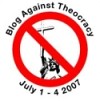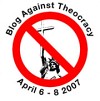Afghanistan makes me sad. Not because "we" are there--I think Canada has a lot to offer that country. I'm just not so sure that we can
do it the way we need to. Let's pretend that the US never raided homes, humiliated/tortured prisoners, suffocated young men in cargo containers...or invaded Iraq. Then---
maybe then---we could have helped Afghanistan the way it deserved to be helped. As it stands today, there is no way that this can be a purely humanitarian mission.
What I'm getting at is the helmet vs. floppy-hat approach. Canadian soldiers (and British, for that matter) do not like to alienate themselves by hiding behind helmets and mirrored sunglasses. That seems a wise approach to making connections with Afghani citizens. And then there was Trevor Greene. Now what do they do?
The following isn't a direct US vs. Canada comparison but
Christian Parenti's article does compare US vs. ISAF/European approaches to counterinsurgency & aid in Afghanistan. First off, Parenti summarizes the failure to properly fund reconstruction & development in the brutalized country:
I am riding along with these two Humvees from the 164th Military Police Company to observe the American effort at keeping a lid on the Afghan caldron. I also want to compare US methods with those of the European troops who are taking over an ever larger part of the military mission here.
[...] The backdrop to this gathering crisis is Afghanistan's shattered economy. The country's 24 million people are still totally dependent on foreign aid, opium poppy cultivation and remittances sent home by the 5 million Afghans living abroad. Yes, there is a new luxury hotel in Kabul, but Afghanistan ranks fifth from the bottom on the UNDP's Human Development Index. Only a few sub-Saharan semi-failed states are more destitute, more broken down.
Since late 2001 the international community--that consortium of highly industrialized nations, international financial institutions, aid organizations and UN agencies that in concert manage the world's disaster zones--has spent $8 billion on emergency relief and reconstruction in Afghanistan. That's a lot of money, perhaps, but given what the World Bank has called the aid sector's "sky-high wastage" and the country's endemic poverty, it's simply not enough.
In the face of Afghanistan's deepening troubles, the US government is now slashing its funding for reconstruction from a peak of $1 billion in 2004 to a mere $615 million this year. And thanks to the military's recruitment problems, the United States is drawing down its troops from 19,000 to 16,000. In short, despite Bush's feel-good rhetoric, the United States is giving every impression that it is slowly abandoning sideshow Afghanistan.
To pick up the slack, the primarily European- and Canadian-staffed, NATO-led International Security Assistance Force is increasing its troop levels from about 9,000 to 15,000. On the economic front an additional $10.5 billion in aid has been pledged for the next five years--$1.1 billion of that promised by the United States; the rest from Japan, the European Union, international institutions and seventy other donor nations.
[...]Many observers hope that a European-led counterinsurgency strategy will be more sophisticated and effective than current American methods, which are rightly criticized as heavy-handed, overly focused on military means, inflexible, culturally insensitive and badly marred by the torture and murder of prisoners at the Bagram detention facility. The next five years--with a new round of funding and an infusion of fresh European troops--are seen as Afghanistan's last chance to stanch the growing Taliban insurgency and build a functioning state.
And the aid? The "good stuff"?
As consolation, Sergeant Chesley begins an aid handout. All the GIs on this patrol have mixed feelings about aid giveaways. "There are villages where they throw themselves in front of our Humvees demanding food and blankets because we've created a welfare mentality," says Chesley. But his instructions are to occasionally give things away, especially in villages where no previous surveys have been conducted.
As the windup radios, blankets and gloves come out, the gaggle of men listening to the survey conversation suddenly swells to a boisterous crowd. The narrow road between the mud wall and the small creek is now full of men and children. There are no women over 15 in sight. Pandemonium is immediate.
Chesley and a village elder attempt to impose order, but it's useless. Every object handed out is seized by several competing men. Shouting children squirm around underfoot. Two younger men start punching each other over a pair of gloves; Chesley and a local intervene to break it up. Now the loser, a skinny guy in a loose shaweer kamis and a Nike ski cap, not only lacks gloves but has hurt pride. More goods come out of the Humvee. A teenager assaults an older man who has just grabbed a blanket; the elder emerges with the blanket but loses his turban. People press in as the victors carry off their trophies.
I jump up on one of the Humvees and shoot video from the safety of the roof. The crowd below is a churning mass of desperation, poverty, hunger and the broken-up pieces of traditional, hierarchical Afghan society.
When we finally pull out of the village, a trail of young boys and men jogging and riding bicycles follows us for about half a mile. Occasionally, one of the GIs throws an MRE out the window. I ride in the gun turret with Specialist Stacey. As far as I can see, the whole pathetic spectacle of the aid handout has had no positive political or cultural impact. "They call us infidels, but they're begging for blankets," says Stacey in his Alabama drawl. He shakes his head and tips a bag of M&Ms into his mouth.
How about the Europeans/ISAF?
Can the Europeans do any better than the US forces? Attempting to find out, I fly to a Lithuanian base called a PRT, for Provincial Reconstruction Team. These small military bases aim to mix peacekeeping and reconnaissance with development work and political support for fledgling local government institutions like the police and the provincial governor's offices.
[...]The Lithuanian-run PRT also includes a small Danish contingent. I am assigned to one of their squads, called a Mobile Liaison and Observation Team, or MLOT. These teams of six soldiers riding in two SUVs are the PRT's main means of operation. Their job is similar to that of the American squad I had been embedded with on the Shomali Plain. The MLOTs here comb their terrain of operations, driving for up to a week at a time, patrolling from village to village, gathering information, mapping the region's strengths and weaknesses, building links to the local population and letting people know that the foreign supporters of the central government are out and about with their guns, grenade launchers and who knows what else.
[...] Unlike the American patrol, with its sloppy, halfhearted, ultimately divisive handouts, the Danes and Lithuanians limit their aid work to a few well-thought-out emergency-response projects: heat for an orphanage, shoes for the children of a displaced persons' camp, a few other things.
The European troops work hard to build bridges to the locals, growing beards, taking off their boots for indoor meetings, learning some Dari. And their sympathy seems genuine.
"I understand why everyone is armed," says Capt. Bo Jepsen while we wait for one of his vehicles to be towed out of the mud. "There is no law and order out here. They have to protect themselves."
Finally, the most depressing part of Parenti's visit to Afghanistan:
Toward the end of my stay I meet a European "contractor" who is in fact a Western intelligence agent in charge of several important dossiers pertaining to Afghan security. All of this is confirmed through Afghan intelligence sources. But my "contractor" friend maintains his pretenses and I remain respectful of that, and we proceed with otherwise very frank conversations.
To my surprise, this agent to the great powers, this builder of empire, is the most cynical person I've met my whole trip. Highly intellectual, he talks of Afghanistan as doomed, a hostage to history and to the idiocy, arrogance and Iraq obsession of the Bush clique. He passes me a series of "red gaming papers"--intentionally dissenting analyses of the Afghan situation written by and for the coalition.
The papers paint an arrestingly bleak picture of Afghanistan as a political "fiction," a buffer state that no longer buffers, a collection of fiefdoms run by brutal local warlords. The coalition's mission is portrayed as a fantasy game managed by sheltered careerists. One of the papers is by an American. It ends on this note: Nothing short of an open-ended blank check from the United States will keep Afghanistan from returning to chaos.
One of our meetings takes place at a dinner party. The contractor and I get rather drunk and talk politics by a big outdoor fire pit. He sums up the situation with a Kipling poem: "When you're wounded and left on Afghanistan's plains/And the women come out to cut up what remains/Just roll to your rifle and blow out your brains/An' go to your Gawd like a soldier."
I can't believe how grim his view of things is (though he is cheerful), and I keep pushing him to test for exaggeration. "I know an Afghan commander who is with the government and has been at this for quite a long time," says the contractor. "He described the current situation as 1983: The Taliban can't take on armored columns yet, but they are building momentum."
This analogy between the present and 1983 seems a bit unfair. "The mujahedeen had US backing," I suggest. "The Taliban have no superpower patron."
"Yes, but neither does Afghanistan," says the contractor. He fills my glass once more with dark red wine and stares into the flames.




































